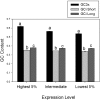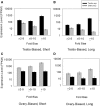Rapid Evolution of Ovarian-Biased Genes in the Yellow Fever Mosquito (Aedes aegypti)
- PMID: 28630112
- PMCID: PMC5560810
- DOI: 10.1534/genetics.117.201343
Rapid Evolution of Ovarian-Biased Genes in the Yellow Fever Mosquito (Aedes aegypti)
Abstract
Males and females exhibit highly dimorphic phenotypes, particularly in their gonads, which is believed to be driven largely by differential gene expression. Typically, the protein sequences of genes upregulated in males, or male-biased genes, evolve rapidly as compared to female-biased and unbiased genes. To date, the specific study of gonad-biased genes remains uncommon in metazoans. Here, we identified and studied a total of 2927, 2013, and 4449 coding sequences (CDS) with ovary-biased, testis-biased, and unbiased expression, respectively, in the yellow fever mosquito Aedes aegypti The results showed that ovary-biased and unbiased CDS had higher nonsynonymous to synonymous substitution rates (dN/dS) and lower optimal codon usage (those codons that promote efficient translation) than testis-biased genes. Further, we observed higher dN/dS in ovary-biased genes than in testis-biased genes, even for genes coexpressed in nonsexual (embryo) tissues. Ovary-specific genes evolved exceptionally fast, as compared to testis- or embryo-specific genes, and exhibited higher frequency of positive selection. Genes with ovary expression were preferentially involved in olfactory binding and reception. We hypothesize that at least two potential mechanisms could explain rapid evolution of ovary-biased genes in this mosquito: (1) the evolutionary rate of ovary-biased genes may be accelerated by sexual selection (including female-female competition or male-mate choice) affecting olfactory genes during female swarming by males, and/or by adaptive evolution of olfactory signaling within the female reproductive system (e.g., sperm-ovary signaling); and/or (2) testis-biased genes may exhibit decelerated evolutionary rates due to the formation of mating plugs in the female after copulation, which limits male-male sperm competition.
Keywords: Aedes aegypti; Genetics of Sex; gonads; molecular evolution; ovary-biased genes; protein sequence divergence.
Copyright © 2017 by the Genetics Society of America.
Figures




Similar articles
-
Evolutionary dynamics of sex-biased genes expressed in cricket brains and gonads.J Evol Biol. 2021 Aug;34(8):1188-1211. doi: 10.1111/jeb.13889. Epub 2021 Jul 16. J Evol Biol. 2021. PMID: 34114713
-
Selection shapes turnover and magnitude of sex-biased expression in Drosophila gonads.BMC Evol Biol. 2019 Feb 20;19(1):60. doi: 10.1186/s12862-019-1377-4. BMC Evol Biol. 2019. PMID: 30786879 Free PMC article.
-
Transcriptome assemblies for studying sex-biased gene expression in the guppy, Poecilia reticulata.BMC Genomics. 2014 May 26;15(1):400. doi: 10.1186/1471-2164-15-400. BMC Genomics. 2014. PMID: 24886435 Free PMC article.
-
The evolution of sex-biased genes and sex-biased gene expression.Nat Rev Genet. 2007 Sep;8(9):689-98. doi: 10.1038/nrg2167. Epub 2007 Aug 7. Nat Rev Genet. 2007. PMID: 17680007 Review.
-
Parental investment, sexual selection and sex ratios.J Evol Biol. 2008 Jul;21(4):919-48. doi: 10.1111/j.1420-9101.2008.01540.x. Epub 2008 May 6. J Evol Biol. 2008. PMID: 18462318 Review.
Cited by
-
Two novel, tightly linked, and rapidly evolving genes underlie Aedes aegypti mosquito reproductive resilience during drought.Elife. 2023 Feb 6;12:e80489. doi: 10.7554/eLife.80489. Elife. 2023. PMID: 36744865 Free PMC article.
-
Transcriptome analysis of sex-biased gene expression in the spotted-wing Drosophila, Drosophila suzukii (Matsumura).G3 (Bethesda). 2022 Jul 29;12(8):jkac127. doi: 10.1093/g3journal/jkac127. G3 (Bethesda). 2022. PMID: 35587603 Free PMC article.
-
Tissue Specificity and Dynamics of Sex-Biased Gene Expression in a Common Frog Population with Differentiated, Yet Homomorphic, Sex Chromosomes.Genes (Basel). 2018 Jun 12;9(6):294. doi: 10.3390/genes9060294. Genes (Basel). 2018. PMID: 29895802 Free PMC article.
-
Absence of a Faster-X Effect in Beetles (Tribolium, Coleoptera).G3 (Bethesda). 2020 Mar 5;10(3):1125-1136. doi: 10.1534/g3.120.401074. G3 (Bethesda). 2020. PMID: 31988160 Free PMC article.
-
Genomic analysis of Sparus aurata reveals the evolutionary dynamics of sex-biased genes in a sequential hermaphrodite fish.Commun Biol. 2018 Aug 17;1:119. doi: 10.1038/s42003-018-0122-7. eCollection 2018. Commun Biol. 2018. PMID: 30271999 Free PMC article.
References
Publication types
MeSH terms
Substances
Grants and funding
LinkOut - more resources
Full Text Sources
Other Literature Sources
Molecular Biology Databases

